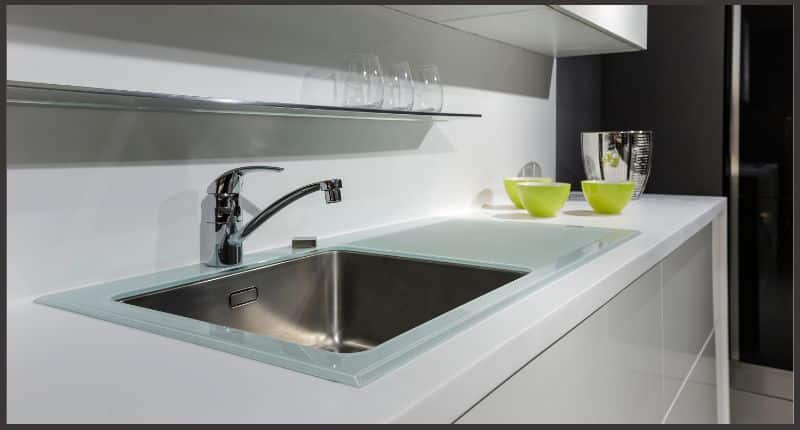Do you need to replace your kitchen sink, or are you just looking to explore more modern designs? No matter your reason, a task that seems quite simple in theory is a complex undertaking in reality – the task of measuring the kitchen sink. A well-kept kitchen is synonymous with a well-maintained home, and investing time in understanding your kitchen sink’s measurements can significantly ease your sink replacement or upgrade process. This article will guide you through the most accurate ways to measure your kitchen sink. Let’s explore how to measure kitchen sink.
Table of Contents
How to Measure Kitchen Sink: Step-by-Step Process
Before you begin, it is crucial to have the following measurement tools on hand: a measuring tape, a ruler, possibly graph paper, and a pencil to jot down the measurements. Make sure your tools are clean to avoid staining or damaging the sink area. Now, let’s dive into the step-by-step process of how to measure kitchen sink:
1. Identify the Type of Sink
Kitchen sinks come in different variations – top-mount, under-mount, or the farmhouse style. Top-mount or drop-in sinks have a rim that overhangs the countertop, while under-mount sinks are installed below the level of the countertop. The farmhouse style, also known as apron-front, has the front section exposed and requires a specific kind of cabinet for installation.
2. Measure the Length and the Width
Start by measuring the sink’s length and width – also known as the ‘cut-out’ dimensions used for the countertop opening. For top-mount sinks, measure the length and width of the sink’s inner part present within the countertop boundaries. For under-mount and farmhouse sinks, take the measurements of the entire sink resting against the countertop.
Place the end of your tape measure on the left inner edge and stretch it to the right inner edge to get the length, while for the width, measure from the front inner edge to the back inner edge.

3. Depth, Bowl Partition and Bowl Sizes
The depth measurement is crucial to ensure a comfortable working position and to prevent water splash. For depth, drop your measuring tape from the top of the sink to the bottom of the sink bowl.
If you have a double-bowl sink, record whether the bowls are equally sized or if one is smaller than the other. Measure the lengths, widths, and depths of both bowls individually.
4. Faucet Hole Spread
Knowing the faucet hole spread is crucial to match the new sink with your current faucet, or if you plan to get a new faucet, this helps you choose the right type. Count the number of holes and measure the distance between them to know the faucet hole spread.
5. Measure from the Front of the Countertop to the Sink
This measurement ensures that there is enough distance from the front of the countertop to the beginning of the sink for the sink to fit correctly.

6. Drain Position
Note the Position of the drain, whether it’s right, left, or center-aligned. It helps while choosing your new sink and ensuring it will align with your current plumbing setup.
Remember, while measuring, always double or even triple-check your numbers. The slightest error could result in a sink that doesn’t fit. It’s essential to jot down the measurements accurately.
Replacements and upgrades are relatively simple tasks when you have the correct, accurate measurements to guide you. So, whether you want to install a brand-new sink or replace the old one, this comprehensive guide should simplify the first, albeit essential, step – the process of measuring your kitchen sink. Happy remodelling!
Additional Guide
If you’re looking to enhance your kitchen’s functionality and style, learning how to build a kitchen island can be a rewarding project. Our step-by-step guide, available at OneKitchenReview.com, will walk you through the entire process, from planning and materials to construction and finishing touches. With this comprehensive resource, you’ll be on your way to creating a beautiful and practical kitchen island in no time.
FAQs
- Why is it important to measure a kitchen sink before installation?
- Accurate measurements ensure that the sink fits properly within your cabinet or countertop, preventing installation issues and costly mistakes.
- What tools do I need to measure a kitchen sink?
- You will need a measuring tape, pen, paper, level, and possibly an adjustable wrench if you need to remove an existing sink.
- How do I measure the width of the cabinet or countertop for the sink?
- Measure the inside width of the cabinet or countertop from one side to the other. This measurement will help you choose a sink that fits the available space.
- How do I measure the depth of the cabinet or countertop for the sink?
- Measure the inside depth of the cabinet or countertop from the front edge to the back. This measurement helps determine how far back the sink can extend.
- What is the depth from the front edge of the cabinet or countertop?
- This measurement determines how far back the front edge of the sink can be from the front edge of the cabinet or countertop. It’s essential for proper sink placement.
- How do I measure the height from the bottom of the cabinet for the sink?
- Measure from the bottom of the cabinet to the top edge where the sink will be installed. This measurement ensures there’s enough space for the sink’s depth and any plumbing connections.
- How do I measure the sink cutout for an undermount or top-mount sink?
- Measure the width and depth of the cutout in the countertop. Additionally, measure the distance from the front edge to the center of the cutout to ensure proper sink placement.
- What is faucet hole spacing, and how do I measure it?
- Faucet hole spacing refers to the distance between the holes where the faucet will be mounted. Measure from the center of one hole to the center of the next to ensure your faucet fits correctly.
- Do I need to measure for additional holes for soap dispensers or accessories?
- If you plan to install a soap dispenser, additional accessories, or a separate sprayer, measure and mark the locations for those holes as well.
- How much clearance and space should I leave around the sink?
- Ensure there’s enough space around the sink for comfortable use. Consider factors like cabinet doors, drawers, and the proximity of other kitchen appliances when measuring for clearance.
- What types of sink installation are there, and how do they affect measurements?
- Sink installation types include top-mount, undermount, flush mount, and farmhouse. The chosen installation type will influence how you measure and prepare for sink installation.
- What should I do if I make a mistake while measuring the kitchen sink?
- Double-check your measurements, and if you discover an error, remeasure and correct it. Accurate measurements are crucial to ensure a proper fit.
- What is the importance of design preferences in sink measurement?
- Your design preferences, such as the sink’s style and finish, will also affect your measurement and sink selection. Ensure your chosen sink complements your kitchen’s overall design.
Remember that precise measurements are crucial to ensure a successful kitchen sink installation. If you have any doubts or concerns, consider consulting a professional or seeking guidance from the sink manufacturer.



